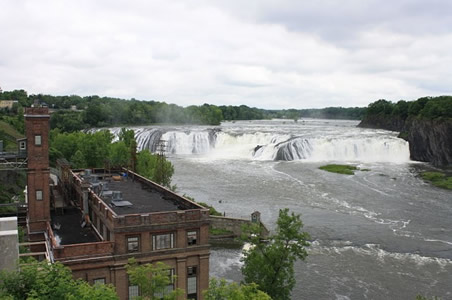A rebirth for a sacred place on the Mohawk
as printed in
![]()
By Doug George-Kanentiio
Published 12:15 a.m., Sunday, October 16, 2011

Cohoes Falls on the Mohawk River
Skennenrahawi, the Peacemaker, walked among the Iroquois more than 800 years ago, his plan was to create the world's first united nations entity dedicated to the idea that human beings may live in a world without war.
To accomplish this, he created a set of rules called the Kaiienerekowa, or the Great Law of Peace. This code not only provided the Iroquois with a constitutional form of government but also directed them to reach out to other nations to present them with an opportunity to join together in a league.
The resulting Haudenosaunee Confederacy would become the most influential aboriginal organization in North America, affecting not only politics but also economics, law, culture and history.
In the Peacemaker epic there are four sites identified with his work. The first is his birthplace in the Bay of Quinte area, west of Kingston, Ontario. The second is south of Rochester, at a location called Ganondagan, where he met Jikonsaseh, the female leader who embraced his teachings and became the first clanmother.
The third was the southern shore of Onondaga Lake. There the Peacemaker, Jikonsaseh and the teacher Hiawatha confronted the sorcerer Tadodaho. They persuaded him to abandon his evil ways and join them in raising the Tree of Peace for all the world to see.
The fourth sacred place was astride the Cohoes Falls on the Mohawk River, just before it flows into the Hudson. There, the Peacemaker was tested by the doubtful Mohawks.
They were intrigued by his message, but placed him on a tall tree above the falls. The branch was cut beneath him, causing his fall into the fast flowing waters. When he emerged unhurt and dry, the Mohawks knew he was indeed a prophet. They became the first people to join what was to become the confederacy.
The problem for the Iroquois has been the loss of these sacred sites to land-hungry colonists in Canada and the United States. Only recently has there been an effort to regain them, beginning with the creation of a spectacular cultural center at Ganondagan, administered by Pete Jemison, a Seneca.
The land along the Cohoes Falls is now back in native hands, thanks to the vision of the late Mohawk Nation Chief Jake Swamp and the hard work of Greg Schaaf, director of the Center for Indigenous Arts and Culture in Santa Fe, N.M., and John Kim Bell, the Kahnawake Mohawk who founded the National Aboriginal Achievement Awards in Canada.
They established an excellent working relationship with the Brookfield Renewable Power Company, a Canadian-based corporation, which had physical possession of the property along the Cohoes Falls and was intrigued by the idea of returning this sacred place to the native people.
Negotiations were begun with Chief Swamp's Tree of Peace Society. When he died in October 2010, the society's board asked the newly formed Hiawatha Institute for Indigenous Knowledge, of which I am vice president, to take over the transfer.
Led by its president Karihwakeron-Tim Thompson, a Wahta Mohawk, the institute agreed. Les Lobaugh, a Navajo attorney and an institute member, used his skills as an environmental specialist to review the legal contracts leading to the actual transfer.
On Sept. 26, Dan Whyte of Brookfield met in Toronto with the Hiawatha Institute delegates at a session organized by John Kim Bell. The land transfer contract was signed and for the first time in 300 years, the Cohoes Falls property was in native hands.
The 110-acre parcel is on the north shore of the Mohawk River, on both sides of the Cohoes Falls. It includes 1,200 feet of water frontage and extends north of the river for about a half mile.
The Hiawatha Institute has yet to finalize its goals for the property, but it will be made available to the Haudenosaunee for cultural purposes. There is the possibility of a learning facility similar to Ganondagan, but no final determinaton has been made.
Doug George-Kanentiio, an Akwesasne Mohawk, is the co-founder of the Native American Journalists Association and the author of "Iroquois on Fire." He also is vice president of the Hiawatha Institute for Indigenous Knowledge, He lives in Oneida Castle. His email address is Kanentiio@aol.com.
